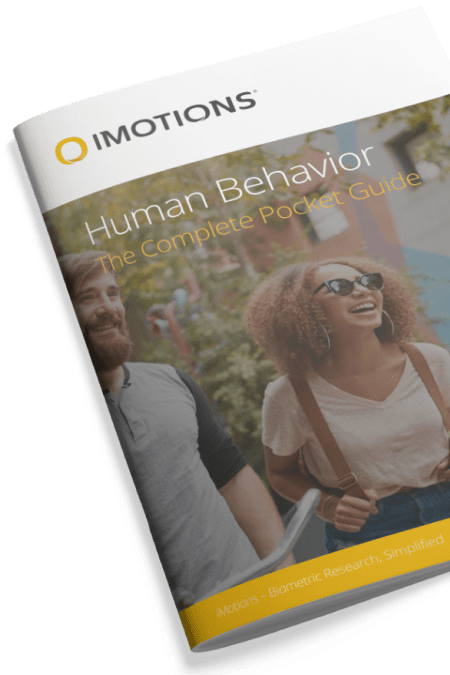Behavioral insights blend psychology, economics, and cognitive science to influence decision-making in public policy and marketing. Technologies like iMotions use biometric sensors to provide comprehensive data on emotional and cognitive responses, helping optimize strategies and ensure ethical research practices.
Table of Contents
Introduction to Behavioral Insights
Everything people do can be considered a behavioral insight, especially when observed systematically. We’ve all encountered images online illustrating the concept of “usage expectation vs. user intent,” such as footpaths worn across lawns that diverge from the paved routes designed by planners. These informal trails, known as “desire paths,” reveal the actual preferences and behaviors of individuals, highlighting a discrepancy between intended design and user behavior.
If you take a good look at the image below, you can easily see the “desire path” going down the side of the football field. Now, if behavioral Insights had been observed, and subsequent amendments made, in the park in question, there would be an official path going down the side of the football field, as that is clearly a path that is being used frequently.

Similarly, consumer behavior can drive significant changes in large corporations, as evidenced by successful boycotts that compel companies to alter their practices or policies. These instances demonstrate the power of collective consumer action as a form of behavioral insight, influencing corporate strategies and market dynamics.
Every action taken by individuals that leads to a change in how things are done provides valuable behavioral insights. These insights are crucial for understanding real-world behavior and improving systems and processes to better align with actual user needs and preferences. By observing and analyzing these behaviors, organizations can refine their approaches, enhance user satisfaction, and foster more effective and user-centric solutions. In fact, this we see in most instances of our lives…
An Example of Behavioral Insights
Let us start this article with a scenario that most of us will be familiar with; you are standing in the check-out line in the supermarket, and you find yourself reaching for one of the sweet treats that will unerringly be displayed very prominently right where you are obliged to stand in order to purchase your groceries. But why do you reach for it, when you have completed an entire sweep of the supermarket without once choosing one of the convenience items that are available both in the shop and by the checkout line? And how do supermarkets know that you are at your most susceptible at that point in your shopping-journey?
Strategic placement of goods in supermarkets is down to a fine art and is all about focusing on historical buying tendencies (impulse and planned) and the psychology of consumer behavior. Supermarkets and other retail environments use these insights into consumer behavior to design store layouts that maximize sales, including the strategic placement of certain products or how to display them in the most appealing manner. By understanding how people make decisions, retailers can effectively influence shopping patterns in subtle but impactful ways.

In the example above, the placement comes down to a few key aspects that have been validated by the millions of shoppers who goes to the supermarkets every day, since the inception of the supermarket concept:
- Impulse buying: An opportunistic placement of goods coupled with waiting time, is the ideal placement for a last-minute, and importantly an inexpensive, indulgent purchase. Studies by Iyer (1989) in the “Journal of Consumer Research” explore how time pressures can increase impulse purchasing.
- Decision fatigue: By the time shoppers get to the checkout, they may be experiencing decision fatigue after making numerous choices throughout their shopping trip. This state makes them more susceptible to easy, low-stakes decisions, like grabbing a chocolate bar or a pack of gum. Vohs et al. (2008) in their study “Decision Fatigue Exhausts Self-Regulatory Resources – But So Does Accommodating to Unchosen Alternatives” detail how decision fatigue impacts consumer behavior at points of purchase.
- High Visibility: Candy is often brightly packaged and designed to catch the eye. When placed at eye level or in easy reach of both adults and children in the checkout area, these colorful, appealing items can attract attention and trigger impulse purchases. The influence of visual merchandising on consumer behavior is well-documented by authors like Bellizzi et al. (1983) in “Color and Position in Retail Displays.”
- Children’s influence: Checkout lines are also strategic for catching the attention of children who accompany their parents. Children are particularly drawn to sweets and are likely to request these items when they see them, leading to potential pester power where children influence their parents’ buying decisions. McNeal (1999) in “Tapping the Three Kids’ Power Markets” provides insight into how children’s preferences impact parental purchases.
- Ease of Access: The convenience of having small, easy-to-handle items at the checkout makes it simple for customers to just add them to their basket without needing to make a significant detour or rethink their purchase decisions.
The example above might not be the most flattering example of how to leverage behavioral insights, but it is none-the-less one of the most ubiquitous. In truth, most aspects of our lives that happen both in private and in the public sphere are partly the result of behavioral insights. How we transport ourselves from A to B, make our coffee in the morning, how we structure our personal finances etc. All of these more or less central aspects of our lives have elements of behavioral insights woven into how we interact with them.
What are Behavioral Insights?
The field of behavioral insights is concerned with how we as people actually act in, and interact with, the world, and not how we believe we act. Behavioral insights blend principles from psychology, economics, and cognitive science to understand and influence human behavior more effectively. This interdisciplinary approach examines how people actually make decisions, often challenging traditional models of rationality. It reveals that decisions are heavily influenced by cognitive biases, emotions, social contexts, and environmental cues, rather than purely logical reasoning (Kahneman, 2011; Thaler & Sunstein, 2008).
For instance, behavioral insights highlight how nudges-subtle modifications in the way choices are presented-can significantly alter behavior without restricting freedom. Simple interventions like changing the default settings on devices or rewording reminders can dramatically improve outcomes in healthcare, finance, and environmental conservation (Thaler & Sunstein, 2008; Halpern, 2015).

Governments and organizations use these insights to design policies and products that are more aligned with human behavior. By employing techniques such as randomized controlled trials, policymakers can empirically test the effectiveness of different strategies, ensuring that interventions are both evidence-based and tailored to actual behavioral patterns, thus enhancing the efficacy of initiatives intended to better society (Shafir, 2013; Benartzi et al., 2017).
The Global Importance of Behavioral Insights
In a time where understanding the complexities of human behavior is more crucial than ever, behavioral insights stand as a driving force in shaping various facets of society. These insights delve into the psychological underpinnings of decision-making, blending theories from psychology, economics, and cognitive science to craft strategies that profoundly influence everyday life.
From enhancing public health initiatives to refining financial products, behavioral insights are instrumental in designing environments and systems that not only anticipate but also positively steer human actions. This nuanced approach to understanding human behavior not only optimizes outcomes across different sectors but also ensures that interventions are more humane, personalized, and effective.
Public Health: Behavioral insights help in designing interventions that encourage healthy behaviors, like quitting smoking or following vaccination schedules. By understanding barriers such as fear, misinformation, or the influence of social networks, health programs can tailor messages that resonate more deeply with target populations, thus increasing their effectiveness (Michie, van Stralen & West, 2011).
Finance: Understanding psychological factors like risk tolerance, the tendency to discount future benefits, and the impact of social norms can help in creating products that encourage savings and responsible investing. Automatically enrolling employees in retirement savings plans with an opt-out option increases participation rates dramatically (Thaler & Sunstein, 2008).
Education: Educational strategies informed by behavioral insights consider factors such as the timing of feedback, the framing of learning goals, and the social environment of students. Insights into motivation, such as the effects of praise versus criticism, can help tailor teaching methods that keep students engaged and improve academic performance (Dweck, 2006).
Environmental Policy: By using nudges, such as defaults for lower energy consumption or social comparisons (e.g., how much energy neighbors use), policymakers can promote sustainable behaviors. Behavioral insights also help in designing better recycling programs by making the processes easier and by providing immediate feedback or incentives (Allcott & Mullainathan, 2010).
Marketing: Marketing benefits significantly from understanding consumer behavior, utilizing tactics that influence purchase decisions. These include placing items strategically in stores, pricing products in a way that enhances perceived value, and creating advertisements that trigger emotional responses or utilize social proof (Cialdini, 2006).
Transportation: In transportation, behavioral insights can lead to designing systems that encourage the use of public transit or carpooling by making them the default option, or by simplifying ticket purchasing processes. Understanding what keeps people from using public transportation can lead to targeted interventions that change travel habits (Litman, 2012).
Human Resources: Insights into workplace behavior can inform policies that boost productivity and job satisfaction. Understanding intrinsic and extrinsic motivators can help in designing reward systems that are more effective. Behavioral insights can also help in creating a workplace culture that fosters collaboration and innovation (Pink, 2011).
Urban Planning: Urban planners can use behavioral insights to design environments that naturally encourage desired behaviors, such as increased physical activity or community engagement. This might include the strategic placement of parks, pedestrian paths, or public seating areas that increase social interactions and physical activity (Gehl, 2010).
Judicial Systems: In judicial systems, behavioral insights can be used to design better decision-making processes that reduce biases, improve fairness, and increase compliance with laws. Simplifying legal communication can help people better understand their rights and obligations, leading to higher compliance rates (Guthrie, Rachlinski & Wistrich, 2001).
Cybersecurity: Cybersecurity efforts benefit from understanding how people perceive risk and security. By framing security practices in a way that emphasizes the personal benefits of adherence or by making secure practices the default setting on software and devices, organizations can significantly improve compliance with security protocols (Acquisti, Brandimarte & Loewenstein, 2015).
Where do behavioral insights come from?
Behavioral insights have a significant impact on various aspects of our lives, from public policy to marketing strategies. These insights help us understand how people make decisions and what influences their behavior in real-world settings. This understanding is crucial as it allows organizations to tailor their approaches to better meet the needs and behaviors of their target audience. But the acquisition of these insights isn’t straightforward-it involves meticulous research and ethical considerations. Technologies like iMotions play a pivotal role in this process.
As many of you will know, iMotions is a comprehensive software platform that integrates and synchronizes multiple biometric sensors to provide detailed human behavioral data. The software utilizes a range of technologies such as eye tracking, facial expression analysis, EEG (electroencephalogram), GSR (galvanic skin response), and heart rate monitoring, among others. These tools enable researchers to capture a holistic view of an individual’s emotional and cognitive responses in various scenarios. By leveraging iMotions, researchers can conduct studies that are both granular and complex, offering insights that are not only based on what participants say but also on what their physiological responses reveal.
For instance, in a university research setting, iMotions can be used to study how students react emotionally and cognitively to different teaching methods. This can provide educators with valuable insights into which practices are most engaging and effective, leading to improved educational outcomes. Similarly, in commercial applications, companies can use iMotions to test consumer reactions to product designs, advertising campaigns, or store layouts, giving businesses a competitive edge by aligning their strategies with actual consumer preferences and behaviors.

The ethical use of behavioral insights and technologies like iMotions is paramount. As researchers collect sensitive personal data, it is crucial to maintain strict data privacy and protection standards. Moreover, the interpretation of this data must be conducted with a clear understanding of its context and limitations. This ethical framework ensures that the insights gained are not only scientifically valid but also morally sound.
Free 52-page Human Behavior Guide
For Beginners and Intermediates
- Get accessible and comprehensive walkthrough
- Valuable human behavior research insight
- Learn how to take your research to the next level

References
- Bellizzi, J. A., Crowley, A. E., & Hasty, R. W. (1983). The effects of color in store design. Journal of Retailing, 59(1), 21-45.
- Iyer, E. S. (1989). Unplanned purchasing: Knowledge of shopping environment and time pressure. Journal of Retailing, 65(1), 40-57.
- McNeal, J. U. (1999). Tapping the three kids’ power markets. American Demographics.
- Underhill, P. (2009). Why We Buy: The Science of Shopping-Updated and Revised for the Internet, the Global Consumer, and Beyond. Simon & Schuster.
- Vohs, K. D., Baumeister, R. F., & Schmeichel, B. J. (2008). Decision fatigue exhausts self-regulatory resources – But so does accommodating to unchosen alternatives. Journal of Personality and Social Psychology, 94(5), 883-898.
- Benartzi, S., Beshears, J., Milkman, K. L., Sunstein, C. R., Thaler, R. H., Shankar, M., Tucker-Ray, W., Congdon, W. J., & Galing, S. (2017). Should governments invest more in nudging? Psychological Science, 28(8), 1041-1055.
- Halpern, D. (2015). Inside the Nudge Unit: How small changes can make a big difference. WH Allen.
- Kahneman, D. (2011). Thinking, Fast and Slow. Farrar, Straus and Giroux.
- Shafir, E. (Ed.). (2013). The Behavioral Foundations of Public Policy. Princeton University Press.
- Thaler, R. H., & Sunstein, C. R. (2008). Nudge: Improving Decisions About Health, Wealth, and Happiness. Yale University Press.
- Acquisti, A., Brandimarte, L., & Loewenstein, G. (2015). Privacy and human behavior in the age of information. Science, 347(6221), 509-514.
- Allcott, H., & Mullainathan, S. (2010). Behavior and energy policy. Science, 327(5970), 1204-1205.
- Cialdini, R. B. (2006). Influence: The Psychology of Persuasion. Harper Business.
- Dweck, C. (2006). Mindset: The New Psychology of Success. Random House.
- Gehl, J. (2010). Cities for People. Island Press.
- Guthrie, C., Rachlinski, J., & Wistrich, A. (2001). Inside the judicial mind. Cornell Law Review, 86, 777.











